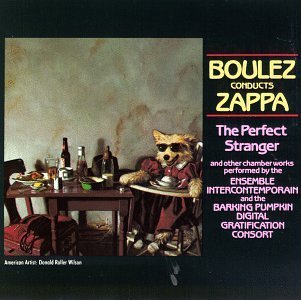Considering that he was never remotely suspected of using cocaine or amphetamines, Prince was a particularly prolific musician. By the time
Parade and
Under The Cherry Moon came out, he was already on his way to having another album ready. Not just another album; first there was the double
Dream Factory, plus the vari-sped
Camille, which were somewhat combined into the triple
Crystal Ball. Eventually, sixteen tracks were spread across two records, released as
Sign "☮" The Times, credited to Prince alone, having disbanded the Revolution the previous fall. Most of his work thus far had been completely solo works anyway, and while the Revolution does appear on a live track recorded the year before, pretty much everything else save the horns and some vocals are all him. (He also had time to record two LPs’ worth of funky smooth jazz under the Madhouse moniker.)
Released ahead of the album, everybody called the infectious title track “minimalist” and it is, based around a simple stock drum pattern, with a few bass runs and lots of bluesy guitar. It’s probably also the last time anybody referred to heroin as “horse”. Lest anyone think he was leaving the funk behind, “Play In The Sunshine” is an upbeat distillation of “1999” and “Delirious”, then—“Shut up already! Damn!”—“Housequake” is an even nastier groove, and pretty funny to boot. (His voice is sped up a tad here, and credited to “Camille” on other instances too.) “The Ballad Of Dorothy Parker” keeps up the funk, and manages to slip in a Joni Mitchell reference halfway through. This is where the album starts to get what people call “eclectic”, and we’re pretty sure it has nothing to do with the legendary wit of the same name.
The meaning of “It” shouldn’t be too hard to figure out, but there’s something about that raspy vocal that cracks us up. The very surreal “Starfish And Coffee” becomes less so when one learns it’s an account of Susannah (and Wendy) Melvoin’s grade school classmates, eventually given a charming reading on a mid-‘90s reboot of The Muppet Show. The horn-infused “Slow Love” fits its title just fine, a Hey Love-style jam with minimal falsetto, and things pick up again on “Hot Thing”. “Forever In My Life” could be called a departure, wherein he expresses a desire for long-term commitment over some subtle yet tasty acoustic guitar.
The idea is swatted away with the surprising hit in the form of “U Got The Look”, basically a duet with Sheena Easton, who had a hit a few years earlier with “Sugar Walls”, and definitely Prince’s type. Here’s where “Camille” truly stands out, seeming to get squeakier with every line. “She” apparently sings “If I Was Your Girlfriend” too, making the pronouns and perspective dizzying. “Strange Relationship” seems like a rearrangement of the same tune, but with a more straightforward structure and no monologue. The extremely catchy “I Could Never Take The Place Of Your Man” was already a terrific single, with its “nah-nah-nah-nah” vocals predicting “November Rain”; on the album it’s extended by about three minutes with a tempo shift and guitar solos before reverting to the original theme.
Despite being only two chords over one bass note, “The Cross” builds from its simple strum to a driving grunge that Lenny Kravitz would eventually cop for three full albums. Suddenly we’re transported back to Paris the previous summer for “It’s Gonna Be A Beautiful Night” with the expanded Revolution, reviving the “oh-wee-oh” Wizard Of Oz chant last heard in “Jungle Love”. Finally, “Adore” says goodnight with another horn-driven slow jam, with about four or five vocal parts weaving in and out of each other at all octaves.
Because the four sides’ worth offer a lot to ingest, Sign "☮" The Times takes a lot of time to appreciate. That said, it’s diverse, a lot of fun, and better than 1999. Pare it down to a single, and it would be even better, but what would you leave off? Besides ending his golden era, it mostly signified the end of the Revolution, and we miss them. (He didn’t tour America behind it, but did release a concert-style film, which did about as well as his previous film, but is worth checking out if you can find it.)
The eventual posthumous expanded version of the album presented a wealth of material for fans and scholars. While the Deluxe Edition merely added all the pertinent single mixes, B-sides, and 12-inch mixes, the behemoth Super Deluxe Edition offered another three discs of tracks from the vault, detailing the progress of the album through all its configurations, finally revealing legendary outtakes, and (of course) adding some stuff that wasn’t part of the soup at all, such as a track with Miles Davis and several songs demoed for pre-comeback Bonnie Raitt. (Two further CDs documented a live show from June 1987, and a DVD presented a New Year’s Eve concert from the newly completed Paisley Park Studios.) While we can’t reconstruct each of the unreleased albums from these contents alone, we can still marvel at his productivity and explorations, and lament the loss of the Revolution—Wendy and Lisa in particular. We’ll even go so far as to say the record company was right, and Sign "☮" The Times was better as a double album than the triple he presented them.
Prince Sign "☮" The Times (1987)—4
2020 Deluxe Edition: same as 1987, plus 13 extra tracks (Super Deluxe Edition adds another 53 tracks, plus DVD)

:format(jpeg):mode_rgb():quality(90)/discogs-images/R-2156020-1320625192.jpeg.jpg)




